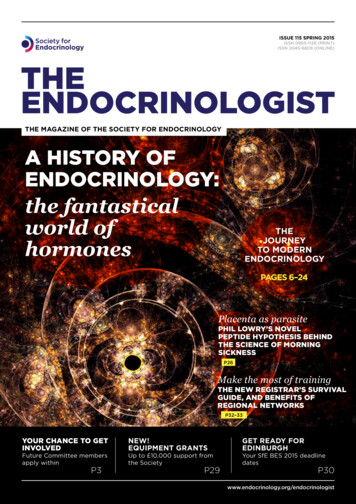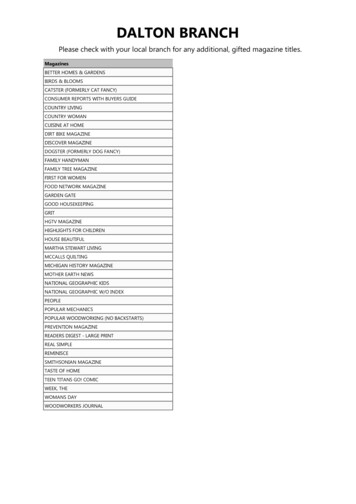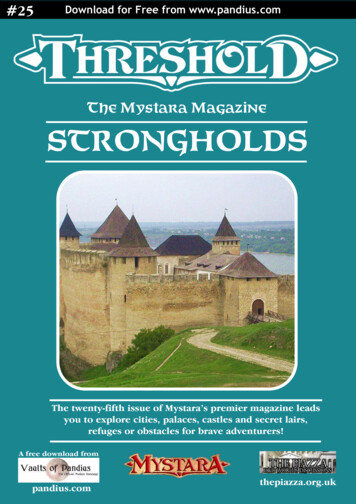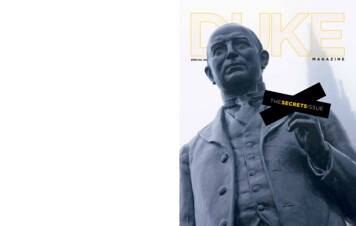
Transcription
ISSUE 115 SPRING 2015ISSN 0965-1128 (PRINT)ISSN 2045-6808 (ONLINE)THE MAGAZINE OF THE SOCIETY FOR ENDOCRINOLOGYA HISTORY OFENDOCRINOLOGY:the fantasticalworld ofhormonesTHEJOURNEYTO MODERNENDOCRINOLOGYPAGES 6–24Placenta as parasitePHIL LOWRY’S NOVELPEPTIDE HYPOTHESIS BEHINDTHE SCIENCE OF MORNINGSICKNESSP26Make the most of trainingTHE NEW REGISTRAR’S SURVIVALGUIDE, AND BENEFITS OFREGIONAL NETWORKSP32–33YOUR CHANCE TO GETINVOLVEDFuture Committee membersapply withinP3NEW!EQUIPMENT GRANTSUp to 10,000 support fromthe SocietyP29GET READY FOREDINBURGHYour SfE BES 2015 ist
WELCOMEA WORD FROMTHE EDITOR Welcome to this ‘History of Endocrinology’ themed edition, which has come together wonderfullywell. We start with an introduction to the fantastical world of hormones, and then take a journeythrough the modern history of pituitary surgery. Following this, we learn about key discoveriesin parathyroid, adrenal, thyroid and oestrogen- and testosterone-related endocrinology. I amvery grateful for the time our big-hitting contributors have given up in order to write for us thistime round.One of the joys of The Endocrinologist magazine is that it allows us to look at over-arching themesin endocrinology and, in so doing, it brings us all together as an endocrine community.Perhaps no publication related to the history of our discipline should omit mention of thename Victor Cornelius Medvei. This man’s enthusiasm and passion for our subject led himto write the definitive textbook, A History of Endocrinology, during his retirement. A copyshould be on every endocrinologist’s bookshelf.As clinicians and scientists or mere enthusiasts, we are all continually contributing tothe progress of our subject, and thereby influencing its present and past. Who knows, someof you reading today’s magazine may be responsible for major breakthroughs in our specialty, andfeature in future historical accounts of endocrine discovery . happy reading!BEST WISHESMILES LEVYCONTENTSON THE COVER P6–24HORMONESTHROUGHHISTORYAn endocrine odysseyIN MY OPINIONP26PHILLOWRYEndocrine secrets ofmorning sicknessYou can view this issue NES3New Editorial Board membersCalls for medallists and nominationsSfE BES shortlisted for best conferenceHOT TOPICS4The latest endocrine researchOPINION27From our Science and Clinical CommitteeCorrespondentsSOCIETY NEWS28Warm welcome for new Officers29Your views on The Endocrinologist, plusgrant and prize newsBecome a contributor Editor:Dr Miles Levy (Leicester)Associate Editor:Dr Tony Coll (Cambridge)Editorial Board:Dr Rosemary BlandDr Dominic Cavlan (London)Dr Paul Foster (Birmingham)Dr Paul Grant (London)Managing Editor: Dr Jennie EvansSub-editor: Caroline BrewserDesign: Corbicula DesignSociety for Endocrinology22 Apex Court, Woodlands,Bradley Stoke, Bristol BS32 4JT, UKTel: 01454 642200Email: info@endocrinology.orgWeb: www.endocrinology.orgCompany Limited by GuaranteeRegistered in England No. 349408Registered Office as aboveRegistered Charity No. 266813 2015 Society for EndocrinologyThe views expressed by contributorsare not necessarily those of the Society.The Society, Editorial Board and authorscannot accept liability for any errorsor omissions.OFFICERSProf S O’Rahilly (President)Prof DW Ray (General Secretary)Prof GR Williams (Treasurer)Prof CJ McCabe (Programme Secretary)COUNCIL MEMBERSProf E Davies, Prof WS Dhillo,Prof NA Hanley, Prof A Logan,Prof JR Seckl, Prof AP Weetman,Dr M Westwood, Prof A WhiteCOMMITTEE CHAIRSClinical: Prof W ArltFinance: Prof GR WilliamsNominations: Prof S O’RahillyNurse: Ms L ShepherdProgramme: Prof CJ McCabePublic Engagement: Prof SA WhiteheadPublications: Prof DW RayScience: Prof KE ChapmanEarly Career Steering Group: Dr S MirczukTHE ENDOCRINOLOGIST ENQUIRIESPlease contact Jennie lease contactadvertising@endocrinology.org30Get talking to your public, plus SfE BESupdate31Becoming the leading publisher inendocrinology and beyondNEXT GENERATION32The New Registrar’s Survival Guide33Trainee benefits of Regional EndocrineNetworksNURSES’ NEWS34Endocrine Nurse UpdateGENERAL NEWS35Acromegaly guidelinesReview of Endocrinology in Clinical PracticeContact the Editorial office at endocrinologist@endocrinology.orgThe Society welcomes news items, contributions, article suggestions and letters to the Editor. We would also like to hear yourfeedback on this issue of the magazine.Deadline for news items for the Summer 2015 issue: 12 March 2015.Deadline for news items for the Autumn 2015 issue: 13 July 2015.Front cover image SHUTTERSTOCK2 THE ENDOCRINOLOGIST SPRING 2015
Find us on Facebook & Twitter c EndoNEW FACES AT THE ENDOCRINOLOGISTSOCIETYCALENDARWe’re delighted to welcome Rosemary Bland andDominic Cavlan (London) as new members of theEditorial Board of The Endocrinologist. Our gratefulthanks go to retiring members Karen Featherstone(Manchester) and Olympia Koulouri (Cambridge)for all their hard work and input over the last 2years.Rosemary BlandThe Editorial Board aims to ensure the views andinterests of all Society members are representedand included in The Endocrinologist. If you wouldlike to contact the Editorial Board with ideas forarticles, topics or your feedback, please emailendocrinologist@endocrinology.org.WHO’S A MEDAL WINNERIN YOUR FIELD?Nominations are sought for the Society’s 2016 Medals.The Dale, Transatlantic, Society, Starling, Europeanand International Medals each honour individuals fortheir significant achievements in endocrinology. Onlythe Society and Starling Medals must be awarded toSociety members; the others are open to any suitablenominees. The deadline for nominations is 31 July2015. You can find full details and nomination forms atwww.endocrinology.org/about/medals.html.WITH REGRETWe were saddened to hearof the untimely death ofJenny Pell of the Universityof Cambridge. Jenny was anactive and valued Societymember. She served asSenior Editor for Journalof Endocrinology (2005–2011),on our Science Committee(until 2008) and as a facultymember at the Autumn Endocrine Retreat (now the CareerDevelopment Workshops). TheSociety extends its condolencesto Jenny’s family and friends.An obituary will appear in ournext issue.26 February 2015NATIONAL CLINICALCASES MEETINGLondon16–17 March 2015ENDOCRINE NURSEUPDATEBirminghamDominic Cavlan16–18 March 2015CLINICAL UPDATEBirminghamNOMINATIONS FORNEXT PRESIDENTProfessor Sir Stephen O’Rahilly will retireas the Society’s President at the 2016 AGM,so a President-elect is sought to commencetheir role in November 2015. Council’snominee for this post is Graham Williams(ImperialCollegeLondon).Ifanymember wishes to suggest an alternative,contact Julie Cragg in the Society office(julie.cragg@endocrinology.org) by 18 March2015.Look out for the brand new Society for Endocrinology blog,THE ENDOCRINE POST!endocrinologyblog.orgNEW COUNCIL AND COMMITTEEMEMBERS NEEDEDYou are encouraged to nominate replacements for Jonathan Seckl,Tony Weetman and Anne White, who retire from the Society’s Councilin November 2015, having served their 4-year terms of office.Vacancies on the Clinical, Early Career Steering Group, Finance, Nurse,Programme, Public Engagement and Science Committees will also ariseat the end of 2015. If you would like to be involved in running yourSociety, please consider standing for election!Details and nominations forms are on the specific committee pages atwww.endocrinology.org/about/committee.html. The closing date is31 July 2015.SPECIALISSUES Don’t forget that JournalofEndocrinology(JOE)and Journal of MolecularEndocrinology (JME), whichare both Society journals,publishregularspecialissues looking back atthe history of endocrinedisorders. Recently, the 20thanniversary of leptin wasmarked in JOE, and 25 yearsof molecular endocrinologywere commemorated in JME.Visit www.try-joe.org andwww.try-jme.org for moreinformation.HEADLINESSfE BES 2014SHORTLISTED FORBEST CONFERENCE12–15 April 2015BNA 2015: FESTIVALOF NEUROSCIENCEEdinburgh2–4 November 2015SOCIETY FORENDOCRINOLOGYBES etings for full detailsGRANTANDPRIZEDEADLINES11 March 2015SUMMER STUDENTSHIPS15 March 2015CONFERENCE GRANTS10 April 2015EARLY CAREER PRIZELECTURE ABSTRACTS4 MAY–6 JULY 2015SfE BES REGISTRATIONGRANTSThe 2014 Society for Endocrinology BESconference has been shortlisted for yetanother award! It is a finalist for ‘BestAssociation Conference – Outside London’in the Association Excellence Awards 2015,which recognise best practice and excellencein professional associations. The SfE BESconference is our Society’s flagship event,designed to bring together the best in UK andinternational endocrinology. We are thrilledthat it has been recognised in this way.27 MAY 2015EARLY CAREER GRANTS27 MAY 2015EQUIPMENT GRANTS15 JUNE–13 JULY 2015UNDERGRADUATEACHIEVEMENT AWARDSseewww.endocrinology.org/grants for full details ofall Society grantsTHE ENDOCRINOLOGIST SPRING 2015 3
HOT TOPICSHTSOCIETY FOR ENDOCRINOLOGYOFFICIAL JOURNALSSociety members have free access to the currentcontent of Journal of Endocrinology, Journal ofMolecular Endocrinology, Endocrine-Related Cancerand Clinical Endocrinology via www.bioscialliance.org.Endocrine Connections and Endocrinology, Diabetes &Metabolism Case Reports, the Society-endorsed casereports publication, are open access (OA) and free to all.JOURNAL OF ENDOCRINOLOGYProgesterone-induced decorin suppresses endometriosisEndometriosis affects 1.5 million UK women. Endometrial cells migrateoutside the uterine cavity, often to the ovaries. Symptoms include pelvicpain, dysmenorrhea, dyspareunia and infertility. Gonadotrophin-releasinghormone (GnRH) agonists and progestins are used as treatment, but notwithout side effects.Ono and colleagues have investigated the effect of dienogest, a progestinwithout systemic androgen activity, on endometrial cells in vitro. Bothdienogest and progesterone elicited anti-proliferative effects on endometrialepithelial and stromal cells through the upregulation of decorin expression.Decorin, a small proteoglycan in the extracellular matrix, was also increasedin patients treated with dienogest.This provides useful insights into progestin action on endometrial cells.Progestins, which are oestrogen-independent, may provide treatmentregimens that are preferable to GnRH agonists, which cause hypooestrogenic side effects, such as hot flushes and bone loss. Whether decorincan be targeted as a treatment for endometriosis and other conditions whereit has been shown to act as a tumour repressor requires further study.Read the full article in Journal of Endocrinology 233 203–216 (OA)JOURNAL OF MOLECULAR ENDOCRINOLOGYAcetylation regulates PPARγ and adipogenesisPeroxisome proliferation-activated receptor gamma (PPARγ) is atranscription factor with important roles in adipogenesis, glucose and lipidmetabolism. Thiazolidinediones (TZDs), through their action on PPARγ, areused to treat type 2 diabetes, but have significant side effects. Alternativemethods to control PPARγ activity may provide preferential treatments.Jiang and coworkers have characterised the activity of acetylated PPARγresulting from the inhibition of histone deacetylase 3 (HDAC3). Theysuggest a model whereby PPARγ is acetylated in the absence of ligand,and is modulated by presence of the corepressor, which includes HDAC3.Dissociation of HDAC3 from PPARγ enables acetylation levels to increase,activating PPARγ and inducing expression of PPARγ target genes,potentially by recruitment of histone acetyltransferases.This indicates that inhibition of HDAC3 may be an alternative way ofcontrolling PPARγ activity and so treating type 2 diabetes without theside effects associated with TZDs. Further studies are required to establishwhether HDAC3 inhibition affects adipogenesis and insulin sensitisation invivo.Read the full article in Journal of Molecular Endocrinology 53 191–200ENDOCRINE-RELATED CANCERCastration promotes cancer cell growth in boneProstate cancer is one of the most common cancers among UK men. Mostcases arise as androgen-dependent tumours that regress under androgenablation therapy. The disease often becomes androgen-independent, atwhich point there is no effective treatment and metastatic spread results inlethality.Metastasis to bone is common, where the microenvironment and increasedbone turnover contribute to tumour growth and progression. Ottewelland colleagues have used in vivo models to show that androgen ablationcaused reduced bone volume and increased the incidence and growthof disseminated prostate cancer cells in bone. This was reversed byadministration of zoledronic acid (ZOL), which inhibits osteoclast activityand bone turnover.ZOL is currently licensed to treat bone complications arising from androgendeprivation. Earlier administration of ZOL, in conjunction with androgendeprivation, may be beneficial in reducing bone loss and preventing prostatecancers metastasising to bone. A phase III clinical trial is underway todetermine whether early ZOL administration is beneficial in prostate cancer.Read the full article in Endocrine-Related Cancer 21 769–781ENDOCRINE HIGHLIGHTSA summary of papers from around the endocrinecommunity that have got you talking.Generation of human pancreatic β cells in vitroType 1 diabetes (T1D) results from the autoimmune destruction of pancreatic β cells causing loss ofinsulin secretion and glucose homeostasis. Transplantation of pancreatic islets enables better glucosehomeostasis than is achieved with exogenous insulin administration. The utility of transplantation islimited by a lack of donor islets, so other sources of functional human β cells are required.Rezania et al. and Pagliuca et al. have described the differentiation of human stem cells into functionalinsulin-secreting β cells in vitro. Both protocols give rise to appreciable numbers of insulin-positivecells, indicating that large scale β cell production could be achieved. The β cells were also shown tofunction in vivo in mouse models of T1D to improve glucose homeostasis. Shutterstock4 THE ENDOCRINOLOGIST SPRING 2015This provides promise for the use of transplanted β cells in T1D, as well as provision of material forpharmacological studies. The degree to which these cells resemble normal endogenous human β cellsis unclear and this requires further investigation.Read the full articles in Nature Biotechnology 32 1121–1133 and Cell 159 428–439
Hot Topics is written by Dominic Cavlan, Tony Coll, Jennie Evans, Karen Featherstone, Paul Foster and Paul Grant.HTCLINICAL ENDOCRINOLOGYOpposing effects of calorie restriction and gastric bypass onFGF21 in obesityLips et al. set out to investigate the effect of different weight loss strategieson levels of fibroblast growth factor 21 (FGF21) in morbidly obese subjectswith normal glucose tolerance (NGT) versus those with type 2 diabetes(T2D). FGF21 has diverse metabolic functions in both the fed and fooddeprived states, with expression regulated by fasting and feeding.Patients with NGT were treated with either gastric banding or Roux-en-Ygastric bypass (RYGB) to achieve weight loss, while patients with T2Dachieved weight loss through RYGB or a very low calorie diet. Patients’levels of FGF21, FGF19 and bile salts were measured before intervention,and 3 and 12 weeks post-intervention.Calorie restriction by gastric banding or a very low calorie diet loweredFGF21 and bile salts, while RYGB raised these levels. As FGF21 is knownto have beneficial metabolic effects, the raised levels of the substance afterRYGB may contribute to this treatment’s success in improving glucosehomeostasis.Read the full article in Clinical Endocrinology 81 862–870ENDOCRINOLOGY, DIABETES & METABOLISM CASE REPORTSGlucagonoma-induced acute heart failureZhang et al. report a 51-year-old woman with glucagonoma who presentedwith left ventricular heart failure and developed cardiogenic shock despitetreatment. Glucagonomas (glucagon-producing pancreatic tumours) are afairly rare type of neuroendocrine tumour (NET) and are usually associatedwith conditions such as multiple endocrine neoplasia type 1 (as was the casehere).The patient was treated with an i.v. infusion of the somatostatinanalogue octreotide and cardiac function steadily improved. Measures ofchromogranin A as a tumour marker were found to be significantly elevated,and these decreased as the patient showed clinical improvement.NETs (other than carcinoid tumours) have not previously been linked withheart failure. The authors suggest that the glucagonoma was the causalfactor for heart failure in this case, and that cardiac function should bemonitored routinely in all NET patients.Read the full article in Endocrinology, Diabetes & Metabolism Case Reports 2014EDM140061 (OA)ENDOCRINE CONNECTIONSStress in patients with diabetes and heart diseaseThe incidence of depression and stress is elevated in patients with diabetesand also in those with heart disease, with stress being an established riskfactor for poor outcome in both groups.The psychological burden of suffering from diabetes and ischaemic heartdisease simultaneously was assessed by Bergmann and colleagues using avariety of questionnaires and the pressure pain sensitivity test. They foundthat patients with both diabetes and heart disease had increased depressivesymptoms. The incidence of chronic stress was elevated compared with thegeneral population, but was similar between patients with heart disease andthose with both conditions.Overall the study indicates that clinicians should account for psychologicalsymptoms, especially depression, when treating patients with multiplechronic disorders.Read the full article in Endocrine Connections 3 156–160 (OA)Jet-lag, obesity and disruption of the gut microbiomeThaiss and coworkers have demonstrated that the circadian rhythms of the gutmicrobiome in mice and humans are disturbed by changes in the host’s biologicalclock, resulting in obesity and the metabolic syndrome.Humans have only relatively recently significantly altered their circadian rhythms,due to lifestyle changes such as shift work or flights across time zones. This behaviourhas been linked to diseases including diabetes, obesity and cancer, but a link to thecircadian clock had not previously been investigated. 123 RF StockThe microbial content of faecal samples from mice and humans was found tochange in line with rhythmic fluctuations associated with the host’sbiological clock. When mice endured changing light–darkness schedules andabnormal feeding habits, the gut microbiome lost its rhythm and altered incomposition. When combined with a high fat diet, these jet-lagged mice gainedweight and developed various metabolic symptoms associated with diabetes.Furthermore, in jet-lagged humans, the composition of the gut microbes also altered,favouring the proliferation of bacteria linked to obesity and metabolic disease.Read the full article in Cell 159 514–529 (OA)Novel intraoperative imaging modality for parathyroid identificationAccurate identification of parathyroid glandsduring thyroidectomy or parathyroidectomy is vitalto the procedure’s success. Their variable location,generally small size and inconspicuous colouring allmake this difficult.McWade et al. report recent progress with theiruse of near-infrared (NIR) autofluorescence imagingto identify the parathyroid gland intraoperatively.Certain molecules demonstrate autofluorescencewhen stimulated by light in the NIR spectrum, andthe authors postulate the presence of such afluorophore in parathyroid tissue.Measurements of NIR autofluorescence in varioustissues in 110 patients undergoing neck surgerydemonstrated up to 25 times more signal fromparathyroid tissue than thyroid, with no signalfrom muscle or fat. Next, they customised a clinicalendoscope camera with an NIR laser and appropriatefilters to collect real time, in vivo NIR fluorescenceimages in six patients, successfully identifyingparathyroid tissue each time.The identity of the fluorophore is unconfirmed, butthe calcium-sensing receptor is the prime candidate.Read the full article in Journal of Clinical Endocrinology& Metabolism 99 4574–4580Leptin links obesity andblood pressureObesity has long been recognisedas a risk factor for the developmentof hypertension. Although severalstrong lines of evidence havepreviously implicated the neuronalcircuitryinvolvedinenergyhomeostasis in this phenomenon,the precise mechanism linking anincrease in fat mass with an increasein blood pressure has remainedelusive.In a tour de force of murinemetabolic phenotyping, Simondset al. have demonstrated that theadipokine leptin, acting on a smallpopulation of neurones withinthe dorsomedial hypothalamus,is the link between weight gain andchanges in blood pressure. Theyneatly combined these data withfindingsfromleptin-deficientsubject who had received leptinreplacement therapy, as well asmeasurements from obese patientswho had lost significant amountsof weight through adherence to arigorous diet and exercise regimen.These findings highlight a potentialnovel therapeutic avenue for thetreatment of obesity-associatedcardiovascular disease.Read the full article in Cell 1591404–1416THE ENDOCRINOLOGIST SPRING 2015 5
FEATUREHORMONES THROUGH HISTORYTHE FANTASTICAL WORLDOF HORMONESWRITTEN BY JOHN WASSThe history of the discovery of hormones aboundswith bizarre experiments, remarkable characters,wrong turns, opportunism and quackery. However,there are elements of genius and amazing tales ofsurvival. The endocrine system may have been thelast to really be discovered, because it is not ananatomical one.THE VOICE OF AN ANGEL lethargic. This demonstrated that myxoedema was caused by thyroiddeficiency and he suggested transplanting tissue from sheep’s thyroidsinto human patients.Obviously this was not a long term cure. However, a pupil of Horsley’s,George Murray (a physician in Newcastle upon Tyne), cut sheep’sthyroids into small parts and put them into carbolic acid, stopperedthem overnight and then filtered them through a handkerchief. Thisproduct he called pink thyroid juice, and he injected it into a 46-year-oldfemale patient. Within 3 months, there was a miraculous improvementin her appearance and her skin was less pale and her energy improved.He carried on with regular injections and this patient lived to the ripeold age of 74.It is difficult to know where to start, but perhaps interesting in conceptis the ‘castrato’, a famous presence in opera in the 16th, 17th and 18thcenturies. Castrati were, of course, operated on before puberty, andhundreds of thousands of them (often from poor families) went throughthe operation until the early 20th century. There is an amazing recordingfrom 1902 of Moreschi, the last papal castrato. Perhaps the most famouscastrato is Farinelli, whose picture can be found in Handel’s house inLondon, and who sung for the ‘mad’ King of Spain every night. Hehad a star career, and perhaps it was this aspiration that led many poorparents to put their sons through such an awful operation.The voice of a castrato was pure and forceful, and they had amazingbreath control. This was largely because their ribs carried on growingand so they had an enormous lung capacity. Of course they experiencedother changes; there was no temporal recession, and their arms andlegs were long. The practice continued until the 20th century, by whichpoint people perhaps realised what was going on.ELIXIR OF LIFE?Interestingly, it was in 1849 that some experiments by Berthold, aGerman physiologist in Göttingen, began to explain the endocrinologyinvolved (although Berthold did not realise this). He experimented oncapons, a great delicacy at that time because of their tender meat. Thesebirds were very docile, and the reason for this was their testes had beenremoved. It was easy to see which these birds were, because the cone(the red bit on the head of the cockerel) was droopy, as was the waffle(the red bit below the jaw). Berthold transplanted testes from intactbirds into the capons’ abdomens, and showed that they redevelopednormal male characteristics. When he did a post mortem, he found thatthe testes had redeveloped their blood supply. However, his discoveriesmade no impact, and ultimately this was a missed opportunity.The next amazing story is that of the famous neurologist Brown-Séquardwho, in 1889 at the age of 72, reported to the Academy of Sciences inParis that he had injected himself with a mixture made up of the bloodfrom testicular veins, semen, and juices of the testicles of dogs or guineapigs. He reported a marked improvement in his strength, stamina andability to concentrate. As might be predicted, his experiments were notreproduced, although they caused considerable excitement throughoutEurope.PINK THYROID JUICEOne of the next exciting discoveries was made by Victor Horsley, afamous surgeon, who had a famously huge social conscience andwas a forcible advocate of free health care for all. He showed that, byremoving the thyroid from monkeys, they developed the changes ofmyxoedema, just like humans. Their hair fell out and they became6 THE ENDOCRINOLOGIST SPRING 2015Sir Victor Horsley in the operating theatre in 1906, National Hospital,Queen Square, London Wellcome Library, LondonThis great fashion for injecting extracts of glands into people workedfor the thyroid, but not in Brown-Séquard’s scenario, obviously becauseof the very different half lives of the two hormones.OVARIAN HYSTERIAUp until the late 1800s, the ovary was thought to be part of the nervoussystem. Viennese gynaecologist Chobrak started removing the ovariesof women in order to treat such conditions as hysteria, anorexia,anxiety and even nymphomania. Joseph Howden in Vienna took theovaries and transplanted them into guinea pigs. He showed that thesereversed the changes caused by oophorectomy. Obviously they had losttheir nervous connections, and this discovery effectively put an end tothe use of oophorectomies. It had a huge implication for the story ofhormones as well.‘He had injected himself with juices of thetesticles of dogs or guinea pigs. He reporteda marked improvement in his strength,stamina and ability to concentrate.’
HORMONES THROUGH HISTORYFEATUREENTER ‘THE HORMONE’Ernest Starling was the first to coin the term ‘hormone’, in the veryearly years of the 20th century. The story goes that Starling was talkingto a colleague at a Cambridge dinner, and they were both strugglingfor a name for these secretions that could pass through another part ofthe body and stimulate it directly. A scholar of ancient Greek suggestedthe word ‘ormao’, the Greek word for ‘excite’ or ‘stir up’ – and thus theword ‘hormone’ entered the language.‘Numerous Steinach operations wereperformed Even WB Yeats had anoperation and reported that it improvedhis creative powers.’Obviously many hormones have since been identified, such as growthhormone in 1932. The discovery of insulin slightly predates that ofgrowth hormone. It had been known since the 19th century that ifthe pancreas was removed from dogs they developed diabetes. Theproblem encountered in studying the pancreas, of course, was thatit makes exocrine and endocrine compounds, and the difficulty wasreally separating these.Frederick Banting, the unlikely discoverer of insulin, was a failed GPin Canada who used to supplement his income by giving lectures tomedical students. It is said that, in the middle of the night, he hit uponthe idea of ligating the pancreatic duct while keeping the dogs alive.Using this approach, the exocrine part of the pancreas became inactive.After 6 weeks, the dogs were sacrificed and their pancreases removed,which enabled insulin to be extracted.The first injection of insulin into Leonard Thompson occurred in 1921,when he was 14 and only days away from death. He was incredibly thinand smelled of acetone. The ‘muck’ made from a dog’s pancreas gaveThompson a whole new lease of life – and the rest, of course, is history.Frederick Banting Wellcome Library, London‘Glanoid’, an early example of ahormone supplement used to treatanaemia, amenorrhoea and menorrhagia. Science Museum, London, Wellcome ImagesTIED UP IN KNOTSBefore we get to the modern day, there was one last amazing wrongturn! Eugen Steinach was a Viennese scientist working in the BiologicalResearch Institute in Vienna. His theory was that if you tied off theduct from the testis (i.e. a modern vasectomy) you would increase theamount of testosterone it produced. Numerous Steinach operationswere performed around the world, with the aim of increasing theamount of testosterone. Even WB Yeats had an operation, at the ageof 69, and reported that it improved his creative powers. Some say heproduced his best poetry after the procedure. He also took up with a27-year-old actress (42 years his junior)!LAST WORDEndocrinology never stands still, and this very selective run throughsome aspects of its history omits many recent triumphs, due to lackof space. The account would not be complete, however, withoutmentioning the discovery of leptin and the amazing work of SteveO’Rahilly and Sadaf Farooqi in Cambridge, in examining genetic causesof obesity with such huge success.Indeed, as you continue your studies, never forget that you are addingto the rich and fantastic trail left by all those endocrinologists who havepreceded us!JOHN WASSProfessor of Endocrinology, University of OxfordAcademic Vice-President of the Royal College of Physicians, LondonTo find out more about ‘The Fantastical World of Hormones’,watch John Wass’ documentary on the subject, which also featuresSadaf Farooqi and Saffron Whitehead, and was first aired onBBC4 in February 2014. You can view the full documentary athttp://bit.ly/1IToJeK.THE ENDOCRINOLOGIST SPRING 2015 7
FEATUREHORMONES THRO
(Imperial College London). If any member wishes to suggest an alternative, contact Julie Cragg in the Society office (julie.cragg@endocrinology.org) by 18 March 2015. NEW FACES AT THE ENDOCRINOLOGIST Dominic Calan Look out for the brand new Society for Endocrinology blog, THE ENDOCRINE POST! endocrinologyblog.org SfE BES 2014 SHORTLISTED FOR











![Tamil Computer Magazine Free [WORK] Pdf](/img/63/tamil-computer-magazine-free-download-pdf.jpg)